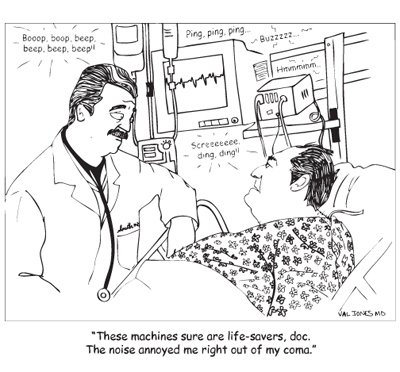January 28th, 2010 by Medgadget in Uncategorized
No Comments »

 To the delight of video game enthusiasts, a new study coming out of MIT has discovered a relationship between the size of certain structures in the brain and the ability to perform in video games. The researchers analyzed the size of specific brain regions of the participants using high-resolution MRI. They then had participants play Space Fortress, (pictured) a game that makes Asteroids look like a technological marvel.
To the delight of video game enthusiasts, a new study coming out of MIT has discovered a relationship between the size of certain structures in the brain and the ability to perform in video games. The researchers analyzed the size of specific brain regions of the participants using high-resolution MRI. They then had participants play Space Fortress, (pictured) a game that makes Asteroids look like a technological marvel.
Here is more from the press release:
Half of the study participants were asked to focus on maximizing their overall score in a video game while paying equal attention to the various components of the game. The other participants had to periodically shift priorities, improving their skills in one area for a period of time while also maximizing their success at the other tasks. The latter approach, called “variable priority training,” encourages the kind of flexibility in decision-making that is commonly required in daily life, according to Kramer. Read more »
*This blog post was originally published at Medgadget*
January 21st, 2010 by Medgadget in Better Health Network, Research
No Comments »


A post on Dan Ariely’s Predictably Irrational draws our attention to Google as a source of data for all sorts of research into human emotions. Dan Ariely, the James B. Duke Professor of Behavioral Economics at Duke University, believes that by using drop down suggestions in Google, we can gain insights into “what people might care the most about concerning a given topic. Read more »
*This blog post was originally published at Medgadget*
January 14th, 2010 by Medgadget in Better Health Network, News
No Comments »

 The perpetually struggling British National Health Service (NHS) is testing a telemonitoring system from Philips in hopes that it will help moderate the cost of providing care to the elderly. The Philips Motiva is a device that hooks up to a television and displays interactive prompts for patients to perform certain tasks, like measuring blood sugar. Via a broadband connection, readings are then sent out to the clinic for overview by a healthcare professional. NHS is hoping that the system will help it reduce the number of in-person patient visits to the hospital, freeing up time for more pressing issues to get their turn.
The perpetually struggling British National Health Service (NHS) is testing a telemonitoring system from Philips in hopes that it will help moderate the cost of providing care to the elderly. The Philips Motiva is a device that hooks up to a television and displays interactive prompts for patients to perform certain tasks, like measuring blood sugar. Via a broadband connection, readings are then sent out to the clinic for overview by a healthcare professional. NHS is hoping that the system will help it reduce the number of in-person patient visits to the hospital, freeing up time for more pressing issues to get their turn.
From The Times of London:
Some 400 patients are being monitored in Newham. Each is provided with diagnostic equipment, such as an SPO2 meter for blood oxygen, which clips on the patient’s finger. The meter is attached to a set-top box linked to the patient’s television. The readings are sent to healthcare staff of the Primary Health Trust, who contact the patient if the readings cause concern.
The Newham trial includes patients with diabetes, heart disease or breathing problems, known as chronic obstructive pulmonary disorder, a condition affecting a million Britons. Read more »
*This blog post was originally published at Medgadget*
January 7th, 2010 by Medgadget in Better Health Network, Medical Art, News
No Comments »

 PaPaLaB Co Ltd, a Japanese firm, has announced their development of the “YC-3300,” a camera they claim can capture the exact same colors as seen by the human eye. The camera is designed for archiving and medical applications. While cameras with similar technology currently exist, they are too large and expensive to be practical. The YC-3300 is currently priced at $140,477, with more affordable models in the pipeline.
PaPaLaB Co Ltd, a Japanese firm, has announced their development of the “YC-3300,” a camera they claim can capture the exact same colors as seen by the human eye. The camera is designed for archiving and medical applications. While cameras with similar technology currently exist, they are too large and expensive to be practical. The YC-3300 is currently priced at $140,477, with more affordable models in the pipeline.
Technology like this will be crucial with cameras in medicine taking an ever larger role in research, education, and diagnosis.
(Hat Tip: Engadget)
Read more at Tech-On…
*This blog post was originally published at Medgadget*
December 29th, 2009 by Medgadget in Better Health Network, News, Research
No Comments »


Students at Northeastern University are developing electronic gloves to help post stroke patients recover their motor skills. The Angle Tracking and Location at Home System (ATLAS) bimanual rehabilitation glove has sensors and a feedback mechanism that interfaces with a computer to allow hand training at home. Read more »
*This blog post was originally published at Medgadget*
 To the delight of video game enthusiasts, a new study coming out of MIT has discovered a relationship between the size of certain structures in the brain and the ability to perform in video games. The researchers analyzed the size of specific brain regions of the participants using high-resolution MRI. They then had participants play Space Fortress, (pictured) a game that makes Asteroids look like a technological marvel.
To the delight of video game enthusiasts, a new study coming out of MIT has discovered a relationship between the size of certain structures in the brain and the ability to perform in video games. The researchers analyzed the size of specific brain regions of the participants using high-resolution MRI. They then had participants play Space Fortress, (pictured) a game that makes Asteroids look like a technological marvel.



 The perpetually struggling British National Health Service (NHS) is testing a telemonitoring system from Philips in hopes that it will help moderate the cost of providing care to the elderly. The Philips Motiva is a device that hooks up to a television and displays interactive prompts for patients to perform certain tasks, like measuring blood sugar. Via a broadband connection, readings are then sent out to the clinic for overview by a healthcare professional. NHS is hoping that the system will help it reduce the number of in-person patient visits to the hospital, freeing up time for more pressing issues to get their turn.
The perpetually struggling British National Health Service (NHS) is testing a telemonitoring system from Philips in hopes that it will help moderate the cost of providing care to the elderly. The Philips Motiva is a device that hooks up to a television and displays interactive prompts for patients to perform certain tasks, like measuring blood sugar. Via a broadband connection, readings are then sent out to the clinic for overview by a healthcare professional. NHS is hoping that the system will help it reduce the number of in-person patient visits to the hospital, freeing up time for more pressing issues to get their turn. PaPaLaB Co Ltd, a Japanese firm, has announced their development of the “YC-3300,” a camera they claim can capture the exact same colors as seen by the human eye. The camera is designed for archiving and medical applications. While cameras with similar technology currently exist, they are too large and expensive to be practical. The YC-3300 is currently priced at $140,477, with more affordable models in the pipeline.
PaPaLaB Co Ltd, a Japanese firm, has announced their development of the “YC-3300,” a camera they claim can capture the exact same colors as seen by the human eye. The camera is designed for archiving and medical applications. While cameras with similar technology currently exist, they are too large and expensive to be practical. The YC-3300 is currently priced at $140,477, with more affordable models in the pipeline.








